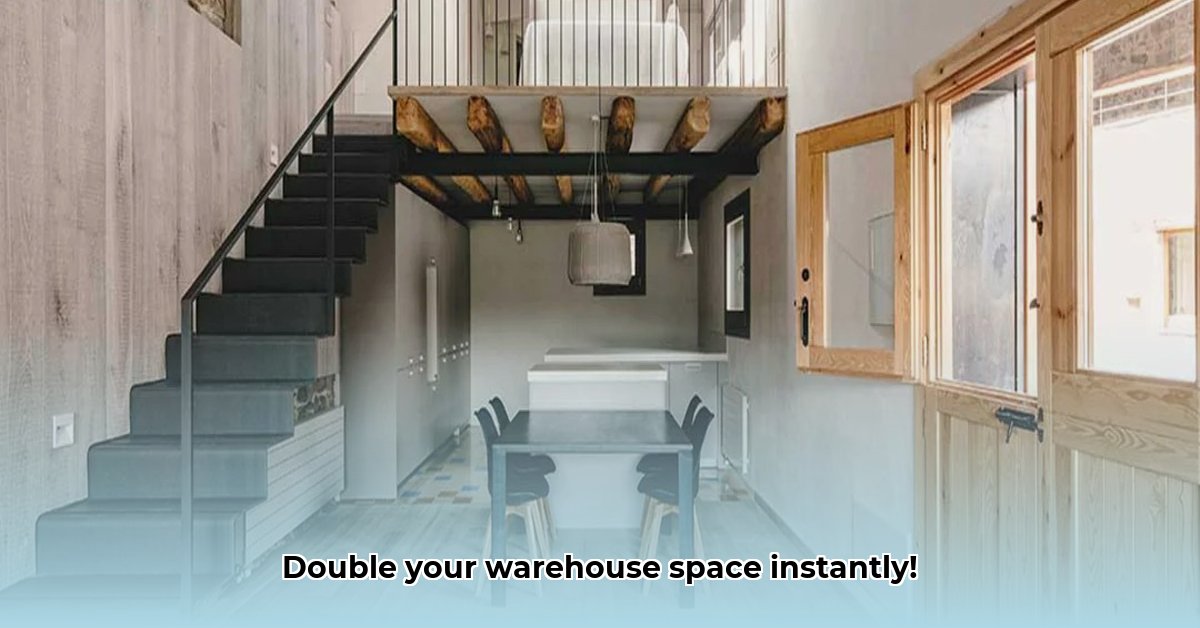Running out of space in your warehouse? Feeling cramped and inefficient? A freestanding mezzanine could be your answer. This comprehensive guide walks you through everything you need to know about these multi-level storage solutions, from initial planning and design to installation and maintenance. We’ll explain the technical aspects in plain language and show you how to choose the right system, prioritize safety, and maximize your investment. Whether you’re a seasoned warehouse manager or simply seeking more space, this guide will help you unlock your warehouse’s full potential. For more information on steel mezzanine systems, check out this resource.
Freestanding Mezzanine Floor Solutions: A Practical Guide
Discover effective warehouse expansion strategies.
Building a freestanding mezzanine floor can revolutionize your warehouse space, offering a cost-effective solution for expansion. This guide breaks down the entire process, from initial planning to ongoing maintenance, empowering you to make informed decisions and optimize your warehouse operations.
Planning Your Mezzanine: Defining Your Requirements
Determine mezzanine load capacity requirements.
Before diving into the specifics of construction, it’s crucial to conduct a thorough assessment of your warehouse’s current and future needs. This goes beyond simply adding extra shelving; it involves creating a functional, safe, and efficient workspace that seamlessly integrates with your existing operations. Consider these key questions:
- What will be stored on the mezzanine? Will it house heavy equipment, lightweight goods, or a combination of both? Determine the total weight the mezzanine will need to support, as well as the concentrated weight in specific areas (point loads). Factor in the density of your storage; high-density shelving necessitates a stronger structural design.
- Who will be using the mezzanine? How many employees will be working on the mezzanine regularly? This impacts safety considerations, such as the number of stairwells, emergency exits, and the overall layout to ensure smooth workflow.
- What equipment will be used on the mezzanine? Will forklifts, pallet jacks, or other heavy machinery be operated on the platform? This factor will inform your decking choices and load-bearing requirements.
- Future-proof your design: Don’t limit your planning to current needs. Project how your storage requirements might evolve over the next five to ten years. A well-designed mezzanine can adapt to future expansion, saving you significant costs and disruptions down the line.
- Establish a realistic budget: Mezzanines can vary significantly in cost, depending on factors such as size, materials, and customized features. Setting a budget early on will help you narrow down your options and avoid any unwelcome financial surprises.
Choosing the Right Mezzanine System: Materials, Design, and Safety
Evaluate mezzanine materials and ensure OSHA and IBC compliance.
Selecting the right components and design is a critical step in building a functional and safe mezzanine. The optimal choice depends on your specific needs, budget, and the intended use of the platform.
Materials:
- Steel: The industry-standard for its exceptional strength and durability.
- Cold-rolled steel: Typically more economical and suitable for lighter loads, making it ideal for storing smaller items or creating office spaces.
- Structural steel: Offers superior strength and load-bearing capacity for heavy-duty applications, such as supporting heavy machinery or high-density storage.
- Decking: The flooring of your mezzanine, with several options available:
- Bar grating: Provides excellent airflow and visibility, which can be crucial for certain applications. Its open design also facilitates cleaning and sprinkler system effectiveness. However, it may not be suitable for small items or equipment with small wheels.
- ResinDek: A high-density composite material which offers a smooth, durable surface that’s compatible with forklifts and other warehouse equipment. Its solid surface also prevents small items from falling through.
- Diamond plate: Offers exceptional durability and a non-slip surface, making it ideal for heavy-duty applications and high-traffic areas. However, it’s generally heavier and more expensive.
- Concrete: The most durable option, suitable for extremely heavy loads and demanding environments. Concrete decking is typically a permanent installation and can add significant weight to the structure.
Safety Considerations:
Safety is paramount. Your mezzanine must adhere to all applicable OSHA (Occupational Safety and Health Administration) and IBC (International Building Code) regulations. These aren’t mere suggestions; they are legally binding requirements designed to protect your workforce.
- Guardrails and handrails: Mandatory around all open edges to prevent falls. Ensure they meet the required height and load-bearing specifications.
- Safety gates: Choose between various types, including:
- Bi-swing gates (swinging in two directions): Often preferred in high-traffic areas for easy access.
- Pivot gates (rotating on a central axis): Provide continuous protection by ensuring one side is always closed.
- Sliding gates: Ideal when space is limited.
- Emergency exits and access: Multiple exits are often required, particularly for larger mezzanines, to ensure safe and rapid evacuation during emergencies. The number of exits should be proportional to the number of people working on the mezzanine and the potential for congestion in escape routes. Consult local building codes for specific requirements.
- Fire suppression systems: Depending on the size and usage of the mezzanine, you may need to extend your existing sprinkler system or install a dedicated fire suppression system to comply with fire safety regulations.
- Lighting: Adequate lighting is essential for safety and productivity. Ensure that the mezzanine is well-lit, with sufficient illumination in all areas.
Design, Installation, and Permits: Partnering with Experts
Ensure structural engineer-backed mezzanine design.
Designing and installing a mezzanine is not a DIY endeavor. Engaging qualified professionals is essential to ensure the structural integrity, safety, and code compliance of your mezzanine floor.
- Structural Engineer: A licensed structural engineer will calculate the necessary load-bearing capacity, taking into account both the overall weight and any concentrated loads, such as heavy machinery. They’ll also ensure that the design integrates seamlessly with your existing warehouse structure and complies with all applicable building codes.
- Experienced Installation Crew: The installation should be performed by a team with proven experience in mezzanine construction. Improper installation can compromise safety and structural integrity.
- Permitting: Obtaining the necessary building permits is crucial before commencing any construction work. Your vendor or contractor can assist with the permitting process, ensuring that your project meets all local regulations.
Maintenance: Protecting Your Investment
Implement mezzanine maintenance checklist.
A freestanding mezzanine represents a significant investment, and regular maintenance is crucial to extend its lifespan and ensure the continued safety of your workforce.
- Regular Inspections: Conduct periodic inspections to identify any signs of wear, damage, or corrosion. Pay close attention to connections, welds, and load-bearing members.
- Cleaning: Keeping the mezzanine clean and free of debris will prevent the accumulation of dust, dirt, and other contaminants that can damage the structure or create safety hazards.
- Lubrication: Lubricate any moving parts, such as those in freight lifts or gates, to ensure smooth operation and prevent premature wear.
- Prompt Repairs: Address any identified issues promptly to prevent them from escalating into more significant problems.
- Budget for Replacements: Plan for the eventual replacement of components as they reach the end of their service life.
Choosing the Right Vendor: Due Diligence is Key
Prioritize vendor experience and compliance.
Selecting the right vendor is a critical decision that can significantly impact the success of your mezzanine project. Don’t simply opt for the cheapest option; prioritize experience, reputation, and compliance.
- Proven Experience: Look for a vendor with a strong track record in similar projects, particularly those that align with the scale and complexity of your needs.
- Positive Reputation: Scan online reviews, solicit references, and speak directly with previous clients to gauge their satisfaction.
- Proper Licensing and Insurance: Verify that the vendor is properly licensed and adequately insured to protect you from liability in the event of accidents or defects.
- Code Compliance Expertise: Ensure that the vendor has a thorough understanding of all relevant building codes and safety regulations, and that they are committed to adhering to them.
- Comprehensive Warranty: A reputable vendor will offer a comprehensive warranty on their products and services, providing you with peace of mind.
Risk Assessment: A Quick Overview
Mezzanine component risk and mitigation.
While a comprehensive risk assessment is best conducted by a qualified professional, the following table provides a simplified overview of potential risks associated with common mezzanine components:
| Component | Risk Level | Mitigation Strategies |
|---|---|---|
| Steel (Cold-rolled) | Moderate | Proper design, careful installation, regular inspection for structural integrity. |
| Steel (Structural) | Moderate | Same as cold-rolled, but even more critical due to higher loads and stresses. |
| Safety Gates | Low to Moderate | Regular inspections and maintenance; ensure proper operation and secure locking. |
| Freight Lifts | High | Thorough inspections, regular maintenance, operator training, safety interlocks, etc. |
| Decking (all types) | Low | Regular inspection for wear and tear; cleaning to prevent debris accumulation. |
A properly planned and installed freestanding mezzanine can dramatically improve your warehouse efficiency and profitability. However, it requires careful planning, expert guidance, and continuous attention to safety. By investing the necessary time and resources upfront, you’ll reap the rewards for years to
- Glass Mosaic Backsplash: A Stylish Upgrade For Your Kitchen - December 8, 2025
- Glass Tile Shower Ideas to Create a Stunning Bathroom Space - December 7, 2025
- Glass Wall Tile Ideas for Kitchens and Bathrooms - December 6, 2025










